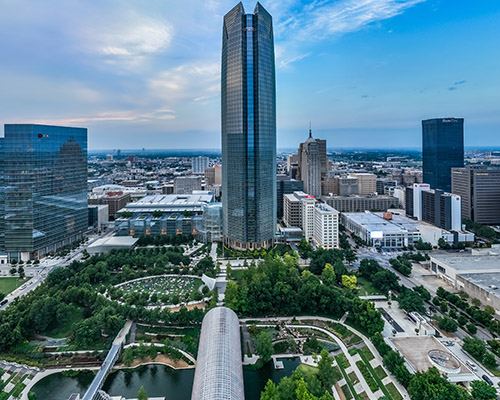By Chamber Staff
The 2024 By the Numbers report from the Greater Oklahoma City Chamber shows that the region continues to experience significant growth and economic expansion. From population increases to sector growth and improvements in workforce development, the report provides an updated snapshot of the area’s ongoing development. Below are some of the key updates:
Population Growth: A 19% Increase Since 2010
Greater Oklahoma City’s metropolitan area now has a population of 1.49 million people, reflecting a 19% increase since 2010. Over the past 14 years, the region has added 233,354 residents. This growth is part of a larger trend of increasing population in the area, which remains one of the fastest-growing metros in the country.
A Diverse and Growing Economy
The economy of Greater Oklahoma City is diverse, with several key sectors showing growth. Aerospace remains a major driver. The region’s aerospace industry employs more than 43,000 people, and between 2015 and 2020, the sector saw a 48% increase in output. Oklahoma City is home to Tinker Air Force Base, one of the largest military maintenance, repair, and overhaul (MRO) facilities in the world, and the FAA Mike Monroney Aeronautical Center, both of which continue to support growth in the aerospace sector.
Advanced manufacturing is another important sector in Greater Oklahoma City, with nearly 1,500 companies employing more than 42,000 people. The region benefits from low tax rates, low utility costs, and a large, productive workforce. Manufacturing in Oklahoma is also supported by the state’s Right-to-Work laws, which have contributed to the sector’s growth.
Biotech also continues to gain ground. The region’s bioscience sector, including healthcare and research, has a gross regional product of $3.3 billion and employs over 40,000 individuals. Significant developments in the Innovation District, including new research labs and office space, are expected to further enhance this sector.
Key Infrastructure: Transportation and Logistics
Greater Oklahoma City’s central location in the U.S. provides significant advantages for businesses, especially those in logistics and distribution. The metro is located at the intersection of three major interstates — I-35, I-40, and I-44 — offering direct access to major markets across the country.
Will Rogers World Airport serves as the region’s primary airport, with eight airlines providing nonstop service to 22 destinations. The region also has access to two Class I railroads, and the Port of Catoosa — one of the largest inland river ports in the U.S. — further strengthens the region’s logistics infrastructure. Additionally, the Port of Houston, a key international gateway, is just 500 miles away.
Workforce: Education and Training
Greater Oklahoma City is home to a workforce of over 825,000 people, with nearly 245,000 students enrolled in local colleges and universities. The region is served by 19 colleges and universities, as well as nine technology centers that provide customized training for businesses.
Oklahoma City’s CareerTech programs are highly regarded and offer free, high-quality workforce training for new and expanding companies. This workforce development infrastructure ensures that businesses have access to a steady stream of skilled labor to meet their needs.
Business Incentives: Support for Growth
Greater Oklahoma City offers a range of state and local incentives to support businesses in the region. These incentives include tax exemptions for certain industries such as manufacturing, warehouse and distribution, and aircraft repair. Manufacturers can also qualify for sales tax exemptions on machinery and equipment, energy costs, and personal property used in the manufacturing process.
In addition, Oklahoma offers Opportunity Zones and Foreign Trade Zones that provide further tax benefits and investment opportunities. On the local level, the City of Oklahoma City’s Strategic Investment Program (SIP) offers cash incentives to businesses that create new jobs and make capital investments within city limits. This program helps attract and retain businesses that contribute to job creation and regional economic growth.
In Conclusion
The 2024 By the Numbers report highlights the ongoing growth and economic strength of Greater Oklahoma City. From a growing population and expanding industries to strong transportation infrastructure and workforce development programs, the region continues to offer significant advantages for businesses. With a diverse economy, skilled workforce, and competitive business environment, Greater Oklahoma City remains a key player in the U.S. economic landscape.
The full 2024 By the Numbers report, including additional details on regional economic trends, sector performance, and available incentives, is available at greateroklahomacity.com.

